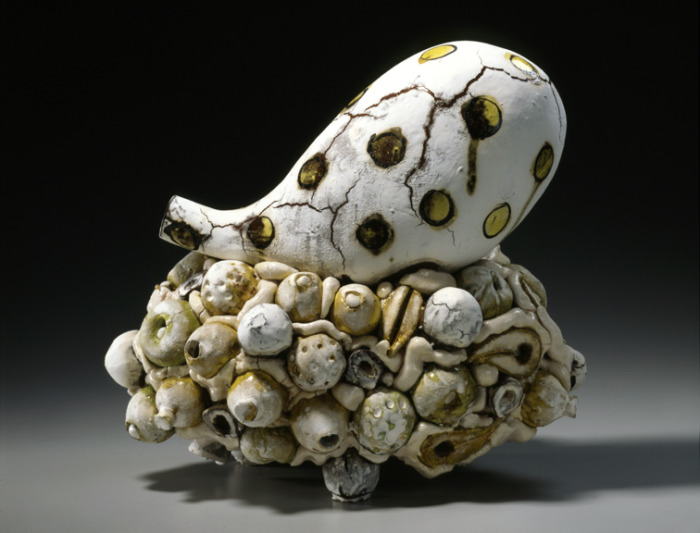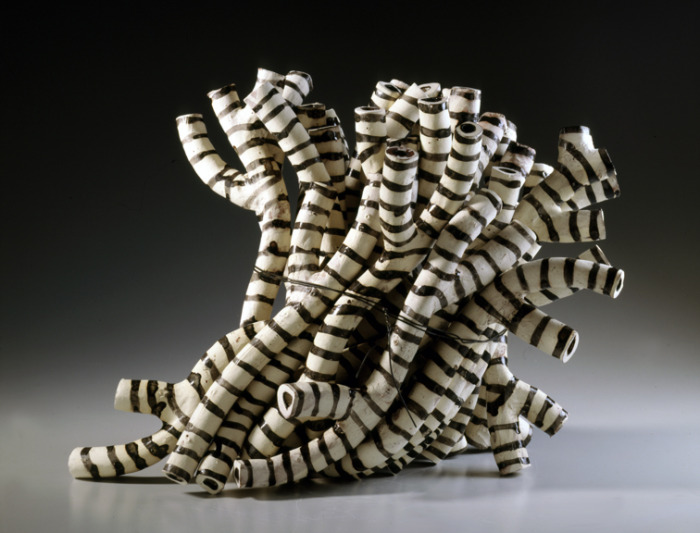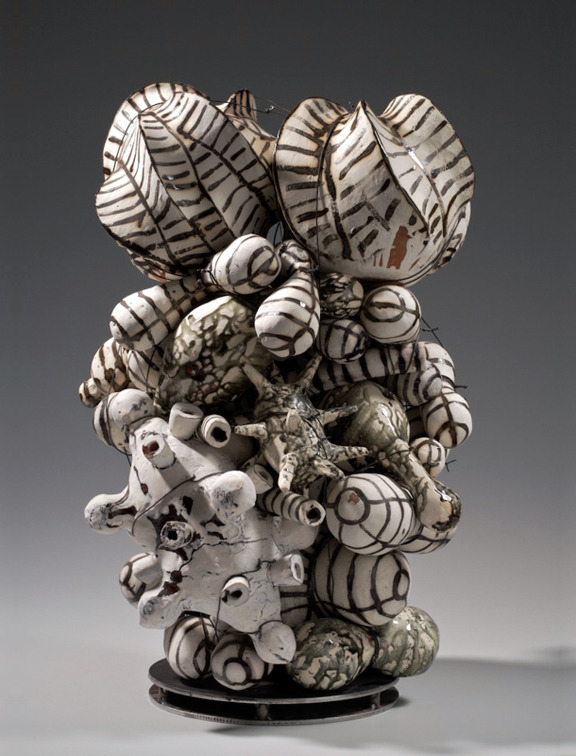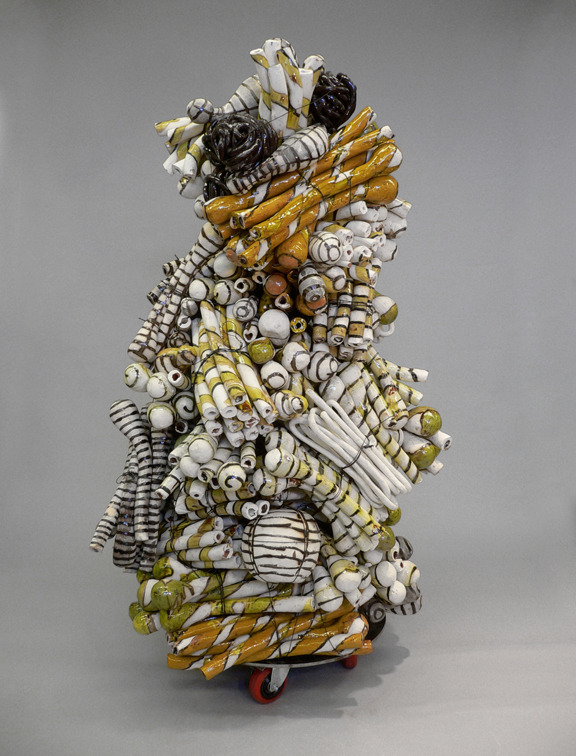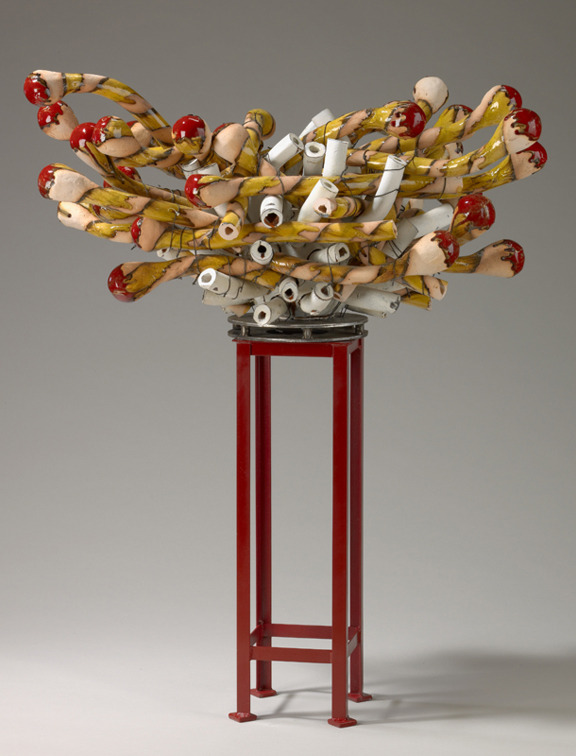WEBSITE: ANNABETH ROSEN
CONTACT:
- 530 219-4917
- arosen@ucdavis.edu
GALLERY: FLEISHER OLLMAN GALLERY, Philadelphia
BIO/CV:
Born in Brooklyn, New York, Annabeth Rosen received her BFA from NYS State College of Ceramics at Alfred University (1978) and her MFA from Cranbrook Academy of Art (1981). After graduate school, Rosen taught at SAIC, RISD, and Bennington College, while participating in residencies, at the Bemis project in Omaha, Watershed in Maine. Since 1997, she has taught at the University of California Davis holding the Robert Arneson Endowed Chair. Rosen has received multiple grants and awards, Pew Fellowship, two National Endowment for the Arts Fellowships and a number of UC Davis Research Grants.
- SOLO SHOWS
- 2012 Center for Contemporary Art, Sacramento, CA
- Gallery Paule Anglim, San Francisco, CA
- 2010 Meulensteen Project Space, New York, NY
- Fleisher/ Ollman Gallery, Philadelphia, PA
- 2008 Gallery Paule Anglim, San Francisco, CA
- 2006 Fleisher/ Ollman Gallery, Philadelphia, PA
- 2003 Nancy Margolis Gallery, NYC,NY (Catalog)
- 2000 john Michael Kohler Art Center Museum, Sheboygen, WI (catalog)
- 1999 Dorothy Weiss Gallery, San Fransisco, CA
- Robert Else Gallery, Sacramento State University, CA
- 1997 Nelson Gallery, University California Davis, Davis, CA
- 1996 Dorothy Weiss Gallery, San Francisco, CA
ARTIST’S STATEMENT
I’ve always needed to work building a momentum, day after day, creating an atmosphere in studio that allows the unexpected to happen, paying attention to the very obvious before me. Sometimes, seemingly disparate things, when joined, can be utterly convincing. In studio, there is very little randomness, and most things are set in motion from a multitude of forces. There is a conscience attempt to be aware of unconscious choices.
Sometimes, how I’ve piled the discarded shapes to the side of where I’m working are closer to the unpremeditated and unpredictable elements sought after, than in the piece I’m making. Stock piling, accumulating parts and pieces, colors, collections, back ups and then back ups for the back up, safeguarding against disaster or deficiency. Making sure, making one, two, three of everything just in case, not to miss something or miss out on foretelling the next step. The extreme malleability of the material and the addictive nature of production in ceramics fuels accumulation.
All of my sources are readily available in the visual world, yet it is through the general urge to create that these sources become visible. It is for this reason that the work stands, or balances on a fine line of stability and instability. It is also the very nature of the ceramic material that allows it to become physically attached to the world of stuff, rather than a digital attachment to the world of information. Informational bricolage as found on blogs, torrents, and youtube, serves as a transient form of cobbling together another world, on information.
I break almost as much ceramics as I make. By being so focused on a destination for the piece, I overlook possibilities. Much of the work is made with already fired parts broken, reassembled, re-glazed and re-fired with the addition of wet clay elements. I work with a hammer and chisel and I think of the fired pieces as being as fluid and malleable as wet clay. A broken shard can be a more potent idea of the object than the object itself and a reminder of how elusive it is to find and identify the elements that excite. And any one piece out of context may reveal the work in a new way.
The nature of clay changes so profoundly in the course of working with it, from this soft brown muck, to a hard and perhaps knowable and useful thing– a real thing in the real world. I want the things I make, even though invented, to be as real and as believable as any other familiar object in the everyday.
WIKIPEDIA
Annabeth Rosen (born 1957 Brooklyn, NY) is an American sculptor, and the Robert Arneson Endowed Chair at University of California, Davis,[1][2][3]
Early life and education
She received her B.F.A in 1978 from the NYS College of Ceramics at Alfred University in Alfred, New York. She then received her M.F.A. in 1981 from the Cranbrook Academy of Art in Bloomfield Hills, Michigan.
Since then her work has been featured all over the world, and she has received numerous awards such as, the National Endowment for the Arts Craftsman Fellowship and a 1992 Pew Fellowship in the Arts.
She taught at Bennington College, from 1993 to 1997.
Work
Explosions of rich thick patterning often characterize Rosen’s work.[4] Her art is most commonly the result of compiling many small organic sculptures of clay to create a much larger, more energetic and dynamic composition. Rosen’s work is rooted, historically, in tile making. At the beginning of her career she made traditional tiles. She began to question the line between craft and art, which caused her to cover her entire apartment in tiles transforming it from a mundane to a spectacular interior space. Her piece entitled Sample helps define where she has gone with her work today. Her work is based on the ideas of functional pottery, decorative architecture and abstract sculpture but her interest is in how her ideas involve and inform the material.[5]
Another underlying theme in Rosen’s work is violence. When she was a child she often watched violent action films. Her studios in New York and Philadelphia were in dangerous neighborhoods so Rosen was constantly surrounded by violence and she found herself intrigued by it. This influence of violence is clearly evident in her raw forms and her approach to aesthetics.[4] The violence is expressed in Rosen’s work by her rough touch. Her raw forms clearly illustrate the forcefulness and roughness in which she touches clay.
While Rosen used to make traditional tiles she is best known for her ceramic sculptures. Rosen’s work is fabulously, gorgeously useless; it acquires its form and purpose from extended dialogue with the functional.[6] She sculpts numerous abstract organic forms and from these individual units creates an entirely new sculptural form. The subunits of clay in her sculptures usually mimic something in nature like a seedpod or a flower. The glazing of her work is generally very colorful and exuberant, meant to contrast with her raw and earthly forms.
Exhibitions
- 1993 “The American Way”. Aberystwyth Arts Centre [3]
- 2004 “Surface & Element”, Solomon Dubnick Gallery[7]
- 2007 New Langton Arts:[8]
- 2008 Gallery Paule Anglim [9]
References
- ^UC Davis art studio faculty
- ^Performance Studies: Affiliated Faculty
- ^ abAnnabeth ROSEN Ceramics Collection Aberystwyth and Ceramic Information 9th October 2010
- ^ ab Scott Chamberlain, “Gravity and Levity,” Because the Earth is 1/3 Dirt, CU Art Museum, 2004, 39-43.
- ^ Brown, Glen R. Annabeth Rosen: Between Drawing and Sculpture, Ceramics: Art and Perception, 2008, No. 72, 62-64.
- ^ Jo lauria, Bay Area Ceramic Sculptors, Ceramics: Art and perception, May 2005, No. 59,16-17
- ^Solomon Dubnick Gallery – Surface and Element
- ^New Langton Arts – San Francisco Art Galleries: January 18, 2007
REVIEW
Quantity seems to be Annabeth Rosen’s central them. It’s perhaps her comment on the nature of ceramics, which are so often produced in large numbers even by individual potters. Or perhaps it was an innate attraction to excess that drew her to ceramics in the first place. A few years ago she was exhibiting masses of vertical cylindrical forms that she squashed between heavy horizontal slabs – as if shelving containing hundreds of thick vases had collapsed when the clay was still wet.
In this show of new works, the New York-born artist, who holds the Robert Arneson chair in ceramics at the University of California, Davis, showed mostly more of less globular forms atop pedestals. But the sense of proliferation was still dominate. These untitled objects seem to have grown into their multiplicity like barnacles on a rock or to have accreted like random stuff caught in a lump of concrete. Many feature one element that is larger that the rest, usually on top. One is funnel-like, another suggests a balloon rising from the ground and some look like bodily organs (a stomach, for example). A few resemble underwater mines that bristle with spikes or knobs.
Some of these masses of both hollow and near-solid things are a beige-pink, and some feature passages of drippy greenish black or splotches of ocher, but the overall effect is dirty white. The charm of this work does not rely upon its palette. What’s engaging is all the roundedness – whether wormlike, knobby, vegetal or faintly figurative – and the sense of animation. There is something of late Guston, a sort of offhand absurdity, although her agglomeration goes against his spatial isolation. Most of the sculpture are raised on balls or small pointed rod-feet, with the notable exception of a mass of snaky tubes painted with black stripes, cinched together with an actual black wire, which stands directly on a pedestal.
Rosen’s drawings in ink plus gouache or acrylic made a striking addition. Two examples look over a wall with multisheet studies of the body-organ shape, while six individual sheets – each a mass of brushstrokes with tube like endings arising from a blur – suggest Rosen’s objects, further animated. Here the motifs somehow look more threateningly medical. In a small room were a dozen diminutive drawings of the tube-masses, more clearly outlined and sometimes on emotive background colors such as peach or red. This intimate scale manages to be just as commanding as the large size. The sculptures, however, do not raise the issue of scale; their power is in their half familiar half teeming with life.
REVIEW
Annabeth Rosen Ceramics, Clare Rojas Paintings
Kenneth Baker Published 04:00 a.m., Saturday, January 21, 2012
Annabeth Rosen‘s ceramic sculptures at Gallery Paule Anglim find a pitch of comic grotesquerie utterly appropriate to their time.
They make no rational sense because they belong to that sparsely furnished class of contemporary artworks that communicate body to body.
They tickle without touch, they frighten without twitching. With their zany and prolix forms they serve as emblems of a culture in which voiceless instinct expresses itself as excess – of accumulation, consumption, impulsiveness or power.
“Bunny” (2011) has much in common with other pieces here. A small upright metal table on casters provides an armature for a dense cluster of writhing glazed and unglazed ceramic forms. They look like proliferating microbes magnified to the size of gourds, both comical and unnerving. A tuberous yellow figure surmounts the piece, suggestive of a heart shorn of any hint of empathy. It recalls the monstrous protagonist of Picasso’s acid, uncaptioned political comic strip “The Dream and Lie of Franco” (1937).
The wormy forms that pervade Rosen’s work echo appendages and organisms to just the right degree to tap into our suppressed awareness of the carnage and bodily and social disfigurements wrought by America’s current wars, and all the rest.
Rojas refashioned: Clare Rojas has long been associated with the so-called Mission school of San Francisco anecdotal painters, so it comes as a pleasant surprise to find her show at Anglim full of abstract paintings.
Rojas’ 2010 exhibition at the Craft and Folk Art Museum took to the limit the narrative and faux-naive qualities of her work. She blanketed the interior with enigmatic figural dramas of recollected or mythologized domestic life.
Her recent abstract work builds on the most involving aspect of the Folk Art Museum show: the interplay in it between existing and painted geometry.
Trying to devise graphically simple, psychologically charged spaces for narrative has sensitized Rojas to the ambiguities of forms and colors that she now deploys on canvas.
“Untitled (CR12006)” (2012) offers a simple example. A flat black cross off center on a white ground, flanked and partially occluded by red triangles, it brings to mind the abstract work of Kazimir Malevich (1878-1935). The painting, like several here, all but offers itself as a flag representing Russian Suprematism or hard-edge abstraction.
Yet the red shapes interact with the black and with the canvas edges in ways that Malevich would have avoided. The triangles appear to slant parallel to one another on the right side and to diverge on the left, hinting at a fracture of vantage point of the sort Rojas formerly used to put a narrative character under implicit psychological pressure.
Here she presents the optical ambiguities as sufficient content, knowing that, for some viewers anyway, tremors of their former function in her work and of their history in abstraction will make themselves felt.
Annabeth Rosen: New Work: Ceramic sculpture; Clare Rojas: Piecemeal:Paintings. Through Jan. 28. Gallery Paule Anglim, 14 Geary St., S.F. (415) 433-2710, www.gallerypauleanglim.com.
REVIEW
“Of all the remarkable things in ceramics,” writes Annabeth Rosen,” the explosion of a piece may be the most shocking.” In addition to recovering the fallout from accidents of the kiln, Rosen works with a hammer and chisel, prying loose fragments of fired clay to form sculptures as gnarly and convoluted as they are explosive. If all the breakage suggests energy verging on violence, her reckless recent works also have an irrepressible buoyancy.
Complex in process as well as character, Rosen’s sculptures, assembled from the agglomeration of distinct sculptural components, often involve chalky white slip fired over deep-colored glazes. The surfaces that result are ashy, as if from the aftermath of disaster, though other associations come to mind; the white powdered faces of classical Chinese theater, or African ritual face painting, a sense of ghostliness and also of power, expressed as something opposite to shadow, an illumination with no external source.
At the same time, humor abounds. In some cases, the glazes are reticulated in a way that mimics cantaloupe rinds or lemon zest. Other forms are dented and fuzzed to suggest fruit gone soft with rot; there are stripes, and knobs, and roundish forms sliced like radishes destined for a plate of crudités. Some components resemble mushrooms or gourds, or gourds so attenuated their rounded heads and elongated tails could be massive sperm; there are also comma-shaped forms that are vaguely vaginal, and an abundance of curving tubular shapes made with extruded clay. In the accompanying catalog essay. Sarah Bodine writes, “The antique surface is analogous to the way old linen begins to yellow, foxing splotches discolor parchment paper, or lichen clings to marble statuary, eating away at nose and fingertip.” But we are also led to less decorous comparisons; festive, clownish, brash, Rosen’s work can evoke a full plate of food begging to be thrown.
Along with a near endless range of surface texture, the sculpture’s overall shapes vary too, though not as widely. The prevailing impression is of living organisms, both emergent ands self-cannibalizing. Some of the sculptures are squat and blocky, others are small towers that taper at midsection and erupt, gently, at the top. Chromus is a short, squarish work that swirls at its core with a snake pit of coiled forms. Glome and Corm are globular, their floury white balls and pods erupting like a spectral bloom, Cinctus I, a pile of tubular and know-headed forms, rises from a square base to a narrow waist before expanding into a crown of distinctly phallic rods. Though Omino is a shade smaller, and its tapering body rises to a crest that is a relatively compact jumble, it positively explodes with color, texture and exuberant formal discord.
Rosen’s earlier work involved variations on ceramic tiles, with sculptural articulation of enormous vigor sprouting from square flat surfaces. These tiles had affinities with architectural ornamentation, from Luca della Robbia’s glazed terra cotta plaques, icons of abundance, to Antoni Gaudi’s improvisatory integration of curvilinear architecture and decoration to Louis Sullivan’s muscular, ornate decorative programs for early skyscrapers. In Rosen’s recent, free standing work, oddly enough, it is easier to see connections to paining; Giuseppe Arcimboldo’s 16th century images of fruits and vegetables that form hidden faces seem relevant, as do Julian Schnabel’s broken-crockery paintings and their unconcealed bravado. An affinity can be discerned, too, with the gestural abstraction of John Camberlain’s sculpture. Indeed, it could be said that what Chamberlain’s early work was to automotive metal, Annabeth Rosen’s is to fired clay: as muscular as it is delicate, and brimming above all with surprise. – Nancy Princenthal
Nancy Princenthal is a New York art critic.
CATALOG ESSAY
ON FIRST IMPRESSION, Annabeth Rosen’s current work as the look of antiquity. There is a chalky white dryness that seems to be eroding in smudgy dark patches. Signs of discoloration and decay suggest a prolonged exposure to the elements. These effects arrive from Annabeth’s layered glazing procedure. Her base clay is a rich brown earthenware that she fires with luminescent glazes – a bilious yellow and an acid chrome green. Atypically, she then recoats the entire surface with a porous white slip. This veil of slip, which cracks and crazes as it expands during firing, allows the clay body or shiny glaze underneath to be reveled, especially at jagged edges or sudden shifts in contour. The underlying glaze, then appears to have erupted, staining the white skin from beneath.
The antique surface is analogous to the way old linen begins to yellow, foxing splotches discolor parchment paper or lichen clings to marble statuary, eating away at nose and fingertip. The balls embedded at the top of this work seem to ooze a shiny brown juice as though rooting on the vine, and the shadowy patches overall resemble years of accumulated soot on a limestone façade, where rain-water rivulets seep into and darken the crusty outer layer, or where residues of ash are eerie reminders of a historical conflagration.
The glaze now appears to be a hint of the past – a pentimento of darkened, fused colors. It is analogous to time and aging, not only in the ceramic process itself, but also in the imagery of nature eroding the manmade, the vagaries of natural forces attacking and overcoming futile attempts at permanence.
A fascination with the antique dates back to Petrarch, the first Humanist gardener, Petrarch viewed his work in garden design as being similar to his poetic oeuvre in promoting the virtues of contemplation and edifying thought of the ancients. There, he employed statuary, architectural ornament and plant arrangements equally with respect to their symbolic power. And so, the Italian Renaissance garden came to be identified more as a product of man than of nature.
Annabeth’s current work similarly uses the power of plant symbolism. These statues are often positioned atop a thick, sturdy ceramic slab, securely grounding them with an architectural platform and establishing a context, a sense of place, for the play of nature and artifice. This is a place of theater – an image of moving, animated line, a packed, undulating mass that casually compresses and distorts the profile of the statuesque form. Her composite shapes, ambiguously lively yet dormant, appear to be tendrils entwining, girding and then growing free from an implied structure beneath, as if nature, over time, has engulfed an old garden sculpture. For artists of the Renaissance, copiousness and abundance in nature translated into the capricious and the strange, resulting in grandiose ornaments of fantastic imagery. This in turn produced greater difficulties in rendering human complexity and invention, placing increased demands on virtuosity.
The distinctive elements of Renaissance architectural ornament have been present in Annabeth’s work throughout her career, especially in the various phases of earlier tile work. In these she adopted the format of the wall-mounted tile or plaque or its contemporary relative the modernist plate. Here is where the precedents of Luca della Robbia, the Quattrocento master of glazed terra-cotta wall reliefs, are instructive. With their appearance of deep relief, Annabeth’s earlier tile work similarly animated the architectural space of the wall. Using a thick, flat slab, either rounded or squared, she applied her signature motifs – abstracted fruit, leaf or flower-bud elements or the suggestion of foodstuffs, olives, macaroni or confections – either serially around the edge or individually in a unified pattern over the entire face of the tile. Now, the tile face itself has expanded into greater relief, the motif packed into chaotic, three-dimensional masses or mounds. These are organized not with any particular pattern in mind but by rhythmic accumulations of elements, including broken shards from previous pieces and newly had formed components that are resembled, reglazed and refired or glued. Each slab has a sort of visual concentricity, which coalesces into focus, as if this is a portrait of an exaggerated tile rather that the tile itself.
Annabeth’s newest work is reminiscent of another Renaissance concept, that of the Mannerist “serpentine.” The theory proposes that to obtain the most graceful figure one should render it twisting like a snake in motion. In this serpentine mode, the posture of the figure reflects an effortless torsion, a movement in space that connotes inter energy, applying equally to both the figure as a whole and to it component parts.
Similarly, a third dramatic Renaissance style – the pastoral – comes to mind. Here notions of artifice and natural world collide presupposing an aura of perfection in nature. The pastoral superseded the merely picturesque. It invoked an ideal richness and harmony through artistic manipulation. The pastoral artist would shear shrubs into tight shapes, compacting the leaves so densely that they began to resemble a green stone, Annabeth does much the same when she compresses thousand of bits of ceramic material, both exploded shards and fragments chiseled off previously fired pieces, into massive cubic forms. For pastoral effects, artists have manipulated nature in many bizarre ways, making it feel bloated, much the same when she compresses thousands of bits of ceramic materials, both exploded shards and fragments chiseled off previously fired pieces, into massive cubic forms. For pastoral effects, artists have manipulated nature in many bizarre ways, making it feel bloated, rough and decomposed, even to the extent of exploding holes in rock to create artificial underground grottos. These grottos test the boundary between natural forms and manmade, manipulated forms, further confusing the age-old question: It is art or is it reality?
Annabeth has been inspired by her move a half dozen years ago to a teaching position at the University of California Davis. Abruptly extracted from a dingy Philadelphia neighborhood, surrounded by dark alleys and decaying brick, she began to experience the boundless world of verdant, sensuous Wet Coast natural growth, although the sensation presumably is not unlike that of the interior of her Philadelphia warehouse studio/loft, which after she had cemented floor-to-ceiling a brilliant mixture of tile mosaics, resembled a living grotto.
Moving to California, she says, initially gave her a profound sense of displacement. But now this feeling has been supplanted by wonder at the abundance and luxuriousness of her new natural surroundings, and has provided fresh imagery and increased dynamic structure to her work. Her current pieces manifest and grapple with the unique interpretation of postures culled from combining the practiced hand of the manmade with nature’s divine model.


